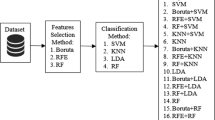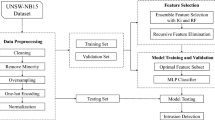Abstract
A novel method based on rough sets (RS) and the affinity propagation (AP) clustering algorithm is developed to optimize a radial basis function neural network (RBFNN). First, attribute reduction (AR) based on RS theory, as a preprocessor of RBFNN, is presented to eliminate noise and redundant attributes of datasets while determining the number of neurons in the input layer of RBFNN. Second, an AP clustering algorithm is proposed to search for the centers and their widths without a priori knowledge about the number of clusters. These parameters are transferred to the RBF units of RBFNN as the centers and widths of the RBF function. Then the weights connecting the hidden layer and output layer are evaluated and adjusted using the least square method (LSM) according to the output of the RBF units and desired output. Experimental results show that the proposed method has a more powerful generalization capability than conventional methods for an RBFNN.
Similar content being viewed by others
References
Beyhan, S., Alci, M., 2010. Stable modeling based control methods using a new RBF network. ISA Trans., 49(4): 510–518. [doi:10.1016/j.isatra.2010.04.005]
Blake, C.L., Merz, C.J., 1998. UCI Repository of Machine Learning Databases, 1998. Department of Information and Computer Science, University of California, Irvine, CA. Available from http://www.ics.uci.edu/mlearn/Machine-Learning.html [Accessed on Sept. 23, 2011].
Chen, S., Cowan, C.F.N., Grant, P.M., 1991. Orthogonal least squares learning algorithm for radial basis function networks. IEEE Trans. Neur. Network, 2(2):302–309. [doi:10.1109/72.80341]
Cheng, J.H., Chen, H.P., Lin, Y.M., 2010. A hybrid forecast marketing timing model based on probabilistic neural network, rough set and C4.5. Exp. Syst. Appl., 37(3): 1814–1820. [doi:10.1016/j.eswa.2009.07.019]
Coelho, L.S., Santos, A.A.P., 2011. A RBF neural network model with GARCH errors: application to electricity price forecasting. Electr. Power Syst. Res., 81(1):74–83. [doi:10.1016/j.epsr.2010.07.015]
Du, D.J., Fei, M.R., Li, L.X., 2008. Radial-basis-function neural network based on fast recursive algorithm and its application. Control Theory Appl., 25(5):827–830.
Du, D.J., Li, K., Fei, M.R., 2010. A fast multi-output RBF neural network construction method. Neurocomputing, 73(10–12):2196–2202. [doi:10.1016/j.neucom.2010.01.014]
Frey, B.J., Dueck, D., 2007. Clustering by passing messages between data points. Science, 315(5814):972–976. [doi:10.1126/science.1136800]
Guerra, A.F., Coelho, L., 2008. Multi-step ahead nonlinear identification of Lorenz’s chaotic system using radial basis neural network with learning by clustering and particle swarm optimization. Chaos Sol. Fract., 35(5): 967–979. [doi:10.1016/j.chaos.2006.05.077]
Hou, M.Z., Han, X.L., 2011. The multidimensional function approximation based on constructive wavelet RBF neural network. Appl. Soft Comput., 11(2):2173–2177. [doi:10.1016/j.asoc.2010.07.016]
Jayasree, T., Devaraj, D., Sukanesh, R., 2010. Power quality disturbance classification using Hilbert transform and RBF networks. Neurocomputing, 73(7–9):1451–1456. [doi:10.1016/j.neucom.2009.11.008]
Jing, X.Y., Yao, Y.F., Yang, J.Y., Zhang, D., 2008. A novel face recognition approach based on kernel discriminative common vectors (KDCV) feature extraction and RBF neural network. Neurocomputing, 71(13–15):3044–3048. [doi:10.1016/j.neucom.2007.08.027]
Lee, C.M., Ko, C.N., 2009. Time series prediction using RBF neural networks with a nonlinear time-varying evolution PSO algorithm. Neurocomputing, 73(1–3):449–460. [doi:10.1016/j.neucom.2009.07.005]
Mao, K.Z., 2002. RBF neural network center selection based on Fisher ratio class separability measure. IEEE Trans. Neur. Networks, 13(5):1211–1217. [doi:10.1109/TNN.2002.1031953]
Mao, K.Z., Huang, G.B., 2005. Neuron selection for RBF neural network classifier based on data structure preserving criterion. IEEE Trans. Neur. Networks, 16(6): 1531–1540. [doi:10.1109/TNN.2005.853575]
Park, H.S., Chung, Y.D., Oh, S.K., Pedrycz, W., Kim, H.K., 2011. Design of information granule-oriented RBF neural networks and its application to power supply for high-field magnet. Eng. Appl. Artif. Intell., 24(3):543–554. [doi:10.1016/j.engappai.2010.11.001]
Pawlak, Z., Grzymala-Busse, J., Slowinski, R., Ziarko, W., 1995. Rough sets. Commun. ACM, 38(11):88–95. [doi:10.1145/219717.219791]
Qu, N., Mi, H., Wang, B., Ren, Y.L., 2009. Application of GA-RBF networks to the nondestructive determination of active component in pharmaceutical powder by NIR spectroscopy. J. Taiwan Inst. Chem. Eng., 40(2):162–167. [doi:10.1016/j.jtice.2008.08.002]
Shen, W., Guo, X.P., Wu, C., Wu, D.S., 2011. Forecasting stock indices using radial basis function neural networks optimized by artificial fish swarm algorithm. Knowl.-Based Syst., 24(3):378–385. [doi:10.1016/j.knosys.2010.11.001]
Su, S., Duan, X.Z., Chan, W.L., Li, Z.H., 2009. Erroneous measurement detection in substation automation system using OLS based RBF neural network. Int. J. Electr. Power Energy Syst., 31(7–8):351–355. [doi:10.1016/j.ijepes.2009.03.008]
Wu, X.J., Zhu, X.J., Cao, G.Y., Tu, H.Y., 2008. Predictive control of SOFC based on a GA-RBF neural network model. J. Power Sources, 179(1):232–239. [doi:10.1016/j.jpowsour.2007.12.036]
Xia, D.Y., Wu, F., Zhang, X.Q., Zhuang, Y.T., 2008. Local and global approaches of affinity propagation clustering for large scale data. J. Zhejiang Univ.-Sci. A, 9(10):1373–1381. [doi:10.1631/jzus.A0720058]
Yu, D.L., Gomm, J.B., Williams, D., 1997. A recursive orthogonal least squares algorithm for training RBF networks. Neur. Process. Lett., 5(3):167–176. [doi:10.1023/A:1009622226531]
Zhang, A.S., Zhang, L., 2004. RBF neural networks for the prediction of building interference effects. Comput. Struct., 82(27):2333–2339. [doi:10.1016/j.compstruc.2004.05.014]
Author information
Authors and Affiliations
Corresponding author
Additional information
Project supported by the National Natural Science Foundation of China (Nos. 41074003 and 60975039), the Opening Foundation of the Key Laboratory of Intelligent Information Processing of Chinese Academy of Sciences (No. IIP2010-1), and the Youth Science Foundation of China University of Mining and Technology (Nos. 2008A045 and 2009A053)
Rights and permissions
About this article
Cite this article
Xu, Xz., Ding, Sf., Shi, Zz. et al. Optimizing radial basis function neural network based on rough sets and affinity propagation clustering algorithm. J. Zhejiang Univ. - Sci. C 13, 131–138 (2012). https://doi.org/10.1631/jzus.C1100176
Received:
Accepted:
Published:
Issue Date:
DOI: https://doi.org/10.1631/jzus.C1100176




